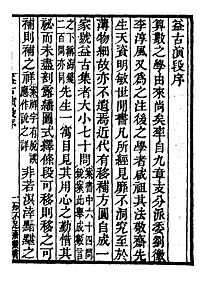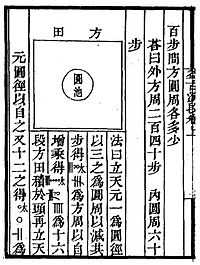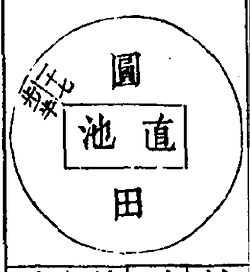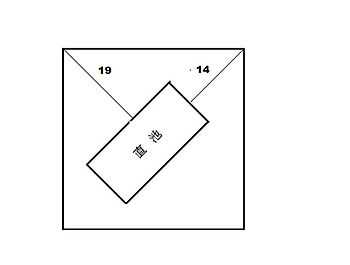Yigu yanduan

Yigu yanduan (益古演段 old mathematics in expanded sections) is a 13th-century mathematical work by Yuan dynasty mathematician Li Zhi. Yigu yanduan was based on North Song mathematician Jiang Zhou (蒋周) Yigu Ji (益古集 Collection of Old Mathematics)which was extinct. However from fragments quoted in Yang Hui's work The Complete Algorithms of Acreage(田亩比类算法大全), we know that this lost mathematical treatise Yigu Ji was about solving area problems with geometry. Li Zhi used the examples of Yigu Ji to introduce the art of Tian yuan shu to new comers to this field. Although Li Zhi's previous monograph Ceyuan haijing also used tian yuan shu, however it is harder to understand than Yigu yanduan.
Yigu yanduan was later collected into Siku Quanshu.
Yigu yanduan consists of three volumes with 64 problems solved with Tian yuan shu in parallel with geometrical method. Li Zhi intended to introduced students to the art of Tian yuan shu thru ancient geometry. Yigu yanduan together with Ceyuan haijing are considered major contribution to Tian yuan shu by Li Zhi. These two works are also considered as the earliest extant documents on Tian yuans shu.
All the 64 problems followed more or less the same format, it started with a question(问), followed by an answer(答曰), a diagram, then an algorithm(术), in which Li Zhi explained step by step how to set up algebra equation with Tian yuan shu, then followed by geometrical interpretation (Tiao duan shu). The order of arrangement of Tian yuan shu equation in Yigu yanduan is the reverse of that in Ceyuan haijing, i.e., here with the constant term at top, followed by first order tian yuan, second order tian yuan, third order tian yuan etc. This later arrangement conformed with contemporary convention of algebra equation( for instance, Qin Jiushao's Mathematical Treatise in Nine Sections), and later became a norm.
Yigu yanduan was first introduced to the western world by the British Protestant Christian missionary to China, Alexander Wylie who wrote:Yi koo yen t'wan...written in 1282 onsists of 64 geometrical problem, illustrated the principle of Plane Measurement, Evolution and other rules, the whole being developed by means of T'een yuen.[1]
In 1913 Van Hée translated all 64 problems in Yigu yanduan into French[2]
Volume I

Problem 1 to 22, all about the mathematics of a circle embedded in a square.
Example: problem 8
There is a square field, with a circular pool in the middle, given that the land is 13.75 mu, and the sum of the circumferences of the square field and the circular pool equals to 300 steps, what is the circumferences of the square and circle respective ?
Anwwer: The circumference of the square is 240 steps, the circumference of the circle is 60 steps.
Method: set up tian yuan one (celetial element 1) as the diameter of the circle, x
 TAI
TAI
multiply it by 3 to get the circumference of the circle 3x (pi ~~3)
 TAI
TAI
subtract this from the sum of circumfereces to obtain the circumference of the square 


 TAI
TAI
The square of it equals to 16 times the area of the square 




 TAI
TAI



Again set up tian yuan 1 as the diameter of circle, square it up and multiplied by 12 to get 16 times the area of circle as
 TAI
TAI


subtract from 16 time square area we have 16 times area of land




 TAI
TAI



put it at right hand side
and put 16 times 13.75 mu = 16 * 13.75 *240 =52800 steps at left,
after cancellation, we get  =0:
=0:




 TAI
TAI



Solve this equation to get diameter of circle = 20 steps, circumference of circle = 60 steps
Volume II

Problem 23 to 42, 20 problems in all solving geometry of rectangle embedded in circle with tian yuan shu
Example, problem 35
Suppose we have a circular field with a rectangular water pool in the center, and the distance of a corner to the circumference is 17.5 steps, and the sum of length and width of the pool is 85 steps, what is the diameter of the circle, the length and width of the pool ?
Answer: The diameter of the circle is one hundred steps, the length of pool is 60 steps, and the width 25 steps. Method: Let tian yuan one as the diagonal of rectangle, then the diameter of circle is tian yuan one plus 17.5*2
multiply the square of diameter with  equals to four times the area of the circle:
equals to four times the area of the circle:
subtracting four times the area of land to obtain:
- four times the area of pool =
 =
= 
now
The square of the sum of length and width of the pool =85*85 =7225
which is four times the pool area plus the square of the difference of its length and width ( )
)
Further
double the pool area plus  equals to
equals to  = the square of the diagonal of the pool
thus
= the square of the diagonal of the pool
thus
( four time pool area + the square of its dimension difference ) - (twice the pool area + square if its dimension difference)
equals  = twice the pool area
= twice the pool area
so four times the area of pool = 
equate this with the four times pool area obtained above
-
 =
=
we get a quadratic equation  =0
Solve this equation to get
=0
Solve this equation to get
- diagonal of pool =65 steps
- diameter of circle =65 +2*17.5 =100 steps
- Length - width =35 steps
- Length + width =85 steps
- Length =60 steps
- Width =25 steps
Volume III

Problem 42 to 64, altogether 22 questions about the mathematics of more complex diagrams
Q: fifty-fourth. There is a square field, with a rectangular water pool lying on its diagonal. The area outside the pool is one thousand one hundred fifty paces. Given that from the corners of the field to the straight sides of the pool are fourteen paces and nineteen paces. What is the area of the square field, what is the length and width of the pool?
Answer: The area of the square field is 40 square paces, the length of the pool is thirty five paces, and the width is twenty five paces.
Let the width of the pool be Tianyuan 1.
 TAI
TAI
Add the width of the pool to the twice the distance from field corner to short long side of pool equals to the length of diagonal of the field x+38


 TAI
TAI
Square it to obtain the area of square with the length of the pool diagonal as its sides





 TAI
TAI
- The length of pool minus the width of pool multiplied by 2 = 2 (19-14) = 10
Pool length = pool width +10:x+10

 TAI
TAI
Pool area = pool with times pool length :x(x+10) =
 TAI
TAI


Area of pool times 乘 1.96 ( the square root of 2) =1.4 )
we have 


 tai
tai
Area of diagonal square subtract area of pool multiplied 1.96 equals to area of land times 1.96:
-
 -
-  :
:






 TAI
TAI
Occupied plot times 1.96 =1150 * 1.96 =2254=
hence = :
:





 TAI
TAI
Solve this equation and we obtain
width of pooll 25 paces therefore pool length =pool width +10 =35 paces length of pool =45 paces
References
- Yoshio Mikami The Development of Mathematics in China and Japan, p81
- Annotated Yigu yanduan by Qing dynasty mathematician Li Rui.

